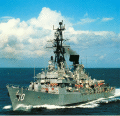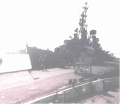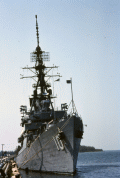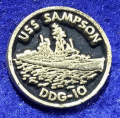Click On Image
For Full Size Image |
Size |
Image Description |
Contributed
By |

| 12k | Rear Admiral William T. Sampson, born at Palmyra, New York , February 9, 1840. Appointed to the United States Naval Academy September 24, 1857, and graduated at the head of his class in 1861. He subsequently earned an LLD degree from Harvard in 1899.
He was promoted to Master, 1861 and commissioned as a Lieutenant July 16, 1862. He was Executive Officer on the ironclad USS Patapsco when it was blown up by mine in Charleston harbor. He was blown into water, but then rescued. Advanced to Lieutenant Commander, July 25, 1866, Commander, August 9, 1874, Captain, March 1889. He was Superintendent of the Naval Academy, 1886-90. An expert on ordnance, torpedoes, etc. With Lieutenant Joseph Strauss, he devised-perfected superimposed turrets introduced into the Navy in February 1898. He was President, Board of Inquiry as to cause of the destruction of the USS Maine in Havana Harbor, February 15, 1898, and after a declaration of war with Spain he commanded the North Atlantic Squadron with the rank of acting Rear Admiral. Promoted to Commodore, 1898, Rear Admiral, 1899. During the Spanish-American his command numbered 125 vessels, the strongest ever organized for hostile purposes. His fleet captured many Spanish merchant vessels and blockade runners and finally defeated the Spanish fleet under Admiral Cevera. Appointed, September 1898, one of three commanders to Cuba. Resumed command of North Atlantic fleet, December 1898. Commandant, Boston USN Yard, Oct 14, 1899. In 1865-67 he served on the USS Colorado in European Squadron, advancing to Lieutenant Commander, July 1866. Again at USNA 1868-71, and, after service on the USS Congress in 1872 and European station in 1873 and promotion to Commander in August 1874, he returned for third tour, 1874-78, as head of Physics Department. 1879-82 he commanded USS Swatara in the Asiatic Squadron, after 2 years as Assistant Superintendent of the Naval Observatory in Washington, DC, during which time was delegate to International Prime Meridian Conference, October 1884, he commanded the Naval torpedo station at Newport from 1884 to 1886. September 1886 named Superintendent of the Naval Academy. Promoted to Captain in March 1889, he left the Academy in 1890 to command the USS San Francisco. 1893-97 he was Chief of the Bureau of Ordnance, where under his leadership much progress was made in such matters as introduction of smokeless powder and improvement of gunnery training. June 1897 given command of new battleship Iowa, joining the North Atlantic Squadron as senior Captain. During February-March 1898 served as president of the Naval Board investigating the sinking of the Maine in Havana harbor. In the latter month he was advanced to acting Rear Admiral, and named to succeed the ailing Montgomery Sicard in command of the North Atlantic Squadron. On declaration of war against Spain in April, he proceeded from Key West to institute a blockade of northern coast of Cuba, his own plan to attack Havana directly having been overruled by the Navy Department. In May while location of the Spanish fleet under Admiral Cevera was yet unknown, he made a cruise east to Puerto Rico and on May 12 bombarded San Juan. He then returned to blockade and joined by "Flying Squadron" under Winfield Scott Schley, who, though technically his senior, was placed under his command for the campaign. He sent Schley to reinforce the blockade of the southern coast, particularly at Cienfuegos and Santiago. Schley was tardy in movements, and Cevera slipped undetected into easily defended harbor at Santiago. When he was finally discovered there, Sampson concentrated his forces outside the harbor. He supported landing of Shafter's army at Daiquiri, June 22, and the capture of Siboney next day, and the subsequent advance to Santiago. Following capture of San Juan heights commanding the city on July 1 he and Shafter arranged a shore conference to plan a coordinated land-sea assault. On morning of July 3 aboard the USS New York, headed for the conference point some miles to east. Half an hour later the first of Cevera's ships appeared, steaming out of harbor to west. The Blockade Squadron, under the immediate command of Schley, went instantly into action and in less than 4 hours entire Spanish fleet was sunk or run ashore. The battle took place entirely to west of harbor entrance, and the New York was out of it altogether. Considerable controversy ensued, with Schley, who had been present aboard the USS Brooklyn, quickly becoming hero of day in papers, while the Navy Department and most knowledgeable observers credited Sampson's training, preparation, and standing orders with the squadron's success. A dispute, bitter at times, delayed promotions for both men for nearly a year. During September-December 1898 in Cuba as 1 of 3 US commissioners. He was made permanent Rear Admiral in March , and resumed command of his squadron until October 1899. He commanded the Boston Navy Yard until October 1901, waiting orders from then until his retirement, February 1902. He died on May 6, 1902, at Washington, DC and it was originally suggested that he be buried at the Naval Academy. He was, however, subsequently buried in Section 21 of Arlington National Cemetery. | Steven A. Cardali |

| 122k | Undated, location unknown. | - |

| 118k | Undated, location unknown. | - |

| 72k | Undated postcard Copyright © Atlantic Fleet Sales, Norfolk, VA. | Mike Smolinski |

| 86k | Undated, location unknown. | Wendell Royce McLaughlin Jr |

| 151k | Undated, location unknown. | Robert M. Cieri |

| 178k | Undated, location unknown. | ssharpbt2 |

| 104k | Undated, location unknown. | Richard Miller BMCS USNR RET. |

| 111k | Undated, location unknown. | Richard Miller BMCS USNR RET. |

| 125k | Undated, location unknown. | Richard Miller BMCS USNR RET. |

| 41k | The launching program May 21 1960. | Gerd Matthes |

| 53k | Mrs. John Crenshaw christens the Sampson May 21 1960. | Gerd Matthes |

| 47k | The launching May 21 1960. | Gerd Matthes |

| 100k | Boston Naval Shipyard, June, 1960 | © Richard Leonhardt |

| 107k | Boston Naval Shipyard, August 1961 | © Richard Leonhardt |

| 26k | Quebec July 1963. | Marc Piché |

| 119k | December 2 1963, location unknown. | Tommy Trampp |

| 75k | Cheseapeake Bay, July, 1964 | © Richard Leonhardt |

| 185k | Early 1966 in the Bosporus off Istanbul, USS Sampson (DDG-10) and USS Richard E. Byrd (DDG-23). | David Meare |

| 73k | Viewed from the USCGC Ingham (WHEC 35) in Guantanamo Bay, Cuba June 1972. | Terry Wright |

| 173k | May 12 1974, Aegean Sea, near Falconera Island. The USS Sampson comes by the Soviet Kashin class DDG Krasny Krim. | Eugene Ivkin |

| 236k | As above. | Eugene Ivkin |

| 89k | USS Barry (DD-933) (left), USS Sampson (DDG-10) (left-center) and USS Richard L. Page (DEG-5) (right) In the harbor at Athens, Greece. This image was received by the Naval Photographic Center in July 1974. Official U.S. Navy Photograph, from the collections of the Naval Historical Center. | Fred Weiss |

| 89k | At Barcelona, Spain, on March 21, 1978. Compared to the photo taken at Boston, in June 1960 (above), this view shows Sampson with the new, improved planar antenna for her SPS-39 3D radar, mounted on her after stack, and a more complex foremast. At the time, she was fitted with an SPS-37 2D air search radar (the larger antenna on her foremast); this was replaced by an SPS-40D in 1981. | Fabio Peña |

| 501k | Moored at Trumbo Point, Naval Station Key West, FL, November 1978. Photo by Raymond L. Blazevic. Image from Flickr courtesy of Florida Keys Public Libraries photo # MM00036141. | Robert Hurst |

| 241k | Moored at Trumbo Point, Naval Station Key West, FL, November 1978. Photo by Raymond L. Blazevic. Image from Flickr courtesy of Florida Keys Public Libraries photo # MM00036309. | Robert Hurst |




Welcome Aboard pamphlet - circa 1978 | Wolfgang Hechler |



Welcome Aboard pamphlet - September 1979 | Manuel García García |

| 85k | The Charles F. Adams-class USS Sampson (DDG 10) alongside the Forrest Sherman-class USS Barry (DD 933). Initially conceived as a missile-armed version of the Forrest Shermans, the Charles F. Adams-class ships had, as actually built, a larger hull with more freeboard forward, for dryness. Note different anchor locations on both ships, reflecting their different sonar domes positions. Barcelona, Spain, Sep. 2, 1979. | Fabio Peña |

| 111k | Closer view, as above. | Fabio Peña |

| 81k | Closer view, as above. | Fabio Peña |

| 81k | Mediterranean 1979. | Marc Piché |

| 55k | DN-SC-83-10459. An SM-1 Standard missile is launched from the guided missile destroyer USS SAMPSON (DDG-10) near the Atlantic Fleet Weapons Training Facility (ATWTR), Puerto Rico. Photo by Rick Moore on June 11 1982. | Bill Gonyo |

| 169k | At Genoa, Italy on December 22 1984. | Carlo Martinelli |

| 58k | Taken between July 1985 and July 1986. The photo was taken by Walt Anhorn, the Missile Officer at that time. | Tim Morgan LCDR, SC, USNR |

| 70k | Operating with USS DWIGHT D. EISENHOWER (CVAN-69) Battle Group, Eastern Mediteranean 1985. | Edward H. Cleary |

| 95k | Circa 1988-1989 while Greg was stationed on board as the Chief Engineer. | Greg Krawczyk, Captain USNR |






Welcome Aboard pamphlet - circa 1990 | Wolfgang Hechler |




Willkommen an Board pamphlet - circa 1990 | Wolfgang Hechler |

| 124k | DN-SC-91-06958. Crew members man the rails aboard the guided missile destroyer USS SAMPSON (DDG-10) as the ship returns to Mayport after serving in the Persian Gulf region during Operation Desert Shield and Operation Desert Storm. Photo by Julie Irwin, March 28 1991. | Bill Gonyo |

| 60k | Cover of the decommissioning pamphlet June 24 1991. | Gerd Matthes |

| 124k | USS Charles F. Adams (DDG-2) and USS Sampson (DDG-10) showing the gangway between the two ships while moored in the Philadelphia Naval Shipyard in November 1999. Photo from Warship Boneyards, by Kit and Carolyn Bonner. | Robert Hurst |

| 57k | Ship's patch. | Mike Smolinski |

| 88k | Ship's coin. | Tommy Trampp |

